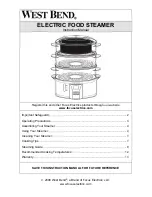
29
NO
SE
FI
GB
DE
DK
PL
ES
3) Instant pressure equalisation
Lift the pressure cooker into a sink and turn
on the cold water tap so that a thin jet of
water hits the lid. The water must not hit
the pressure regulator, pressure indicator or
handle, and the pressure cooker must not
be submerged in water.
The water rapidly cools the pressure cooker
so that the pressure is equalised and the lid
can be removed.
Removing the lid
Never try to remove the lid when the
pressure cooker is pressurised.
Hold by the handles (11, 12) and push the
release button (10) forward so that the
remaining steam is released via the steam
hole (5) at the front of the pressure cooker.
Turn the upper handle (11) anticlockwise
until the (•) mark on the lid (6) is lined up
with the (•) mark on the lower handle (12).
Lift the lid off vertically.
Safety devices
The pressure cooker is equipped with a
number of safety devices:
1) Lid lock
When the pressure in the pressure cooker
exceeds 5 kPa, the lid cannot be removed.
2) Pressure regulator
The pressure regulator is used to set the
maximum pressure in the pressure cooker. If
the pressure exceeds this, steam is released
through the pressure regulator to lower the
pressure.
3) Safety valve
If the pressure regulator unexpectedly fails,
the safety valve ensures that the pressure in
the pressure cooker cannot exceed 180 kPa.
4) Gasket
If both the pressure regulator and safety
valve fail, the gasket is forced open when
the pressure rises to between 200 and 280
kPa. The pressure in the pressure cooker
then falls to below 20 kPa within 1 minute.
Cleaning and maintenance
Wash the pan (2), lid (6) and gasket (4) in hot
soapy water after each use. Do not use steel
wool or scouring pads as they can damage
the surface. The parts must not be washed
in the dishwasher.
Check that the steel balls in the safety valve
can move.
Check the seal. If it is worn, torn or
damaged, it should be replaced.
The pressure cooker must not be stored
with the lid fi tted to it.
















































